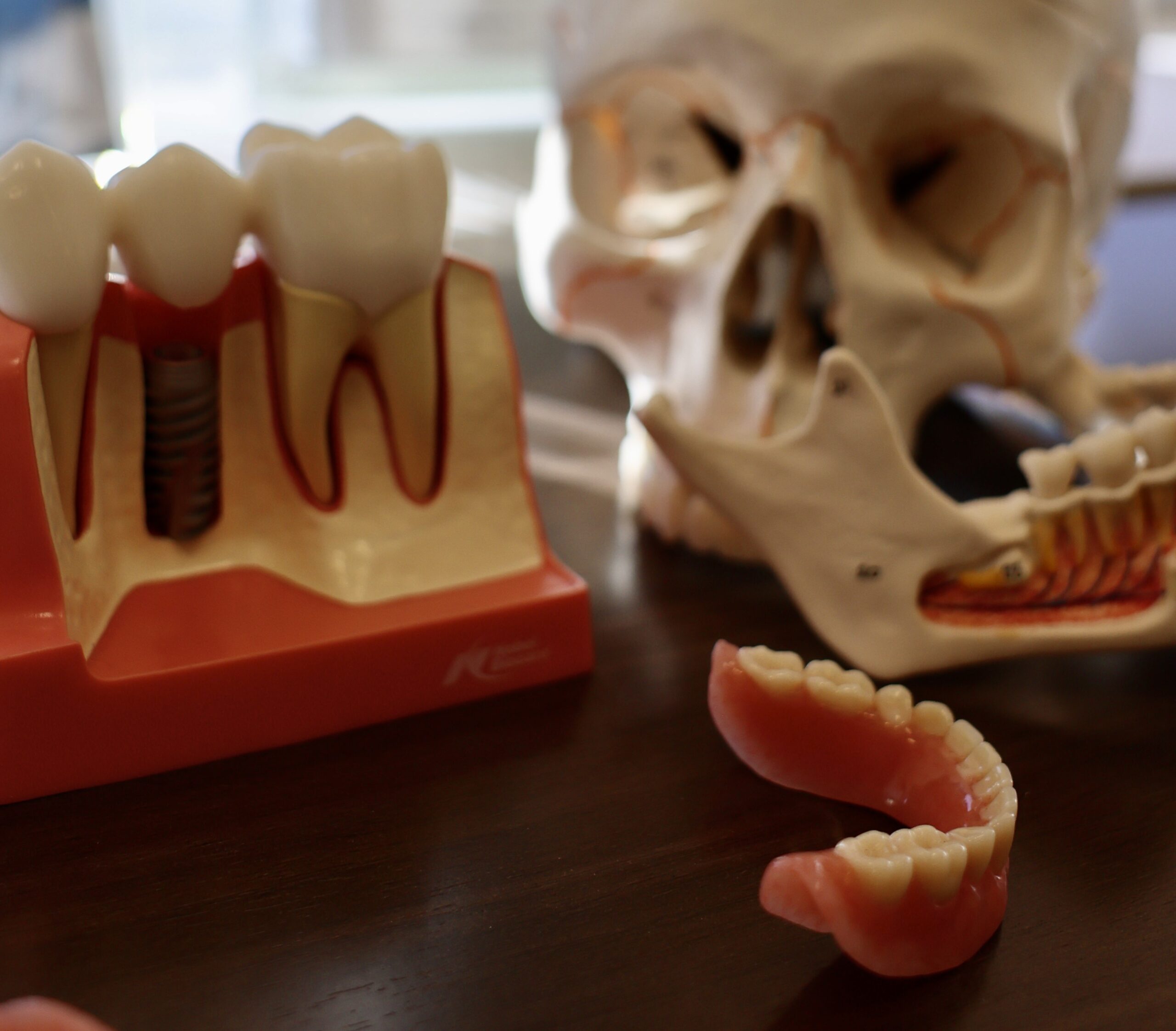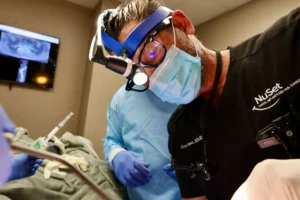Are you considering dental implants and wondering how the crown is attached? Dental implants can help restore your smile and confidence, but it’s natural to have questions when considering this significant dental procedure. Here at NuSet, we’re here to support you every step of the way.
Let’s explore how the process works so you can make the best decision for your dental health.
What is a Dental Implant?
A dental implant is a small titanium post that a dentist places into your jawbone. It acts like the root of a natural tooth, providing a strong base for a dental crown. Dental implants are popular for replacing missing teeth because they are durable and look like real teeth.
The components of a dental implant include the following:
Implant post
The implant post is typically made of titanium, a material that is compatible with the human body. The dentist surgically inserts this post into your jawbone, where it fuses with the bone over time. This process is called osseointegration.
Zirconia implants, constructed from the exceptionally resilient and biocompatible material zirconia, are prized for their ability to mimic the strength and aesthetics of natural teeth closely. Serving as a dependable substitute for conventional titanium implants, zirconia implants present a range of practical and emotional advantages that cater to the diverse needs of dental patients.
There are other materials that can be used for dental implants as well, including ceramic.
Abutment
Once the implant post is securely in place, our oral specialist attaches an abutment to it. The abutment is a connector that holds the crown. It screws into the implant post and sticks out above the gum line, ready to hold your new restoration in place.
Crown
The crown is the visible part of the implant that looks like a natural tooth. It is custom-made to match the color and shape of your other teeth. The crown is attached to the abutment, completing the restoration.
Types of Dental Crowns for Implants
When you get a dental implant, the crown is the part that looks and functions like a natural tooth. There are different ways to attach the crown to the implant, and each method has pros and cons.
Cement-retained crowns
Dentists use dental cement to attach these crowns to the abutment. The cement securely holds the crown, providing a strong and stable fit.
Cement-retained crowns look natural because there are no visible screws or holes. This makes them a great option for front teeth, where appearance is crucial.
However, once cemented, these crowns are difficult to remove. If the crown needs repair or adjustment, the dentist might have to break it, which can be inconvenient and costly.
Screw-retained crowns
These crowns are attached to the abutment using screws. The screw goes through a hole in the crown and secures it to the implant.
Screw-retained crowns are easier to remove and replace. If repairs or adjustments are needed, the dentist can easily unscrew the crown without damaging it. This type of attachment is often used for back teeth where the screw hole is less visible.
The con of screw-retained crowns is that the screw hole can sometimes be visible, which might not look as natural as a cement-retained crown. The hole is usually filled with a tooth-colored material, but it may still be noticeable. Having an experienced dental specialist work on your dental implants ensures you will get the exact results you desire.
How a Crown is Attached to a Dental Implant
Understanding how a crown is attached to a dental implant can help ease any concerns you might have. Here’s a step-by-step overview of the procedure, from the initial consultation to the final placement of the crown.
Initial consultation and planning
The process begins with a complimentary consultation with your specialist at NuSet, who will discuss your dental needs and goals. We will examine your mouth using 3D imaging to assess the condition of your jawbone and plan the placement of the implant.
Based on the examination, our team will create a customized treatment plan. This plan outlines the steps involved, including any necessary preparatory procedures like bone grafting.
Placing the implant
Your NuSet oral surgeon will surgically place the implant post into your jawbone. This is done under local anesthesia or IV sedation dentistry to ensure you are comfortable during the procedure. You will have complete choice over which type of sedation or anesthesia, and we’ll ensure you’re taken care of every step of the way.
After placing the implant, a healing period of eight weeks to six months is needed. During this time, osseointegration occurs, where the implant fuses with the jawbone to provide a stable foundation for the crown.
Healing and osseointegration
This is a critical phase where the implant integrates with the bone. It typically takes three to six months. Proper integration ensures the implant is strong and capable of supporting the crown.
During this period, we provide you with a temporary tooth or teeth, so you don’t have to walk around with a space in your mouth.
Attaching the abutment and crown
The abutment serves as a connector between the implant and the crown. After placing the abutment, your NuSet oral surgeon will take impressions of your teeth to create a custom crown that matches the color and shape of your natural teeth.
The final step is attaching the crown to the abutment. This can be done using dental cement or screws, depending on the type of crown chosen.
This procedure ensures that the dental implant and crown function like natural teeth, providing a durable and aesthetically pleasing solution for missing teeth.
Factors to Consider When Choosing Between Cement-Retained and Screw-Retained Crowns
Choosing the right type of crown for your dental implant is important for both aesthetics and functionality. Here are some factors to consider when deciding between cement-retained and screw-retained crowns.
What are your aesthetic preferences?
Let’s look at your options:
- Cement-retained crowns: Cement-retained crowns offer a more natural look. Since there are no visible screws or holes, these crowns are ideal for front teeth where appearance is crucial.The dental cement used is tooth-colored, blending seamlessly with your natural teeth.
- Screw-retained crowns: Screw-retained crowns may have a visible screw hole, which can be filled with tooth-colored material. However, the fill material might still be noticeable, making them less ideal for front teeth.
Maintenance
- Cement-retained crowns: Once cemented, these crowns are difficult to remove. If the crown needs repair or replacement, the dentist may have to break it, which can be inconvenient and costly. Cement can seep into the gum line, causing inflammation and other complications.
- Screw-retained crowns: These crowns are easier to remove and replace. If repairs or adjustments are needed, the dentist can simply unscrew the crown without damaging it.
The ease of removal makes screw-retained crowns a better option for back teeth, where adjustments and maintenance might be more frequently required.
To help you make the right decision, we will consider your specific dental needs, the location of the implant, and your aesthetic preferences. We will also explain the benefits and drawbacks of each option.
Get Your Dental Implants at NuSet Dental Implants and Oral Surgery
Are you considering dental implants? At NuSet Dental Implants and Oral Surgery, we offer top-notch dental implant services to restore your smile and confidence. Our expert team ensures that your implant surgery is performed with precision and care, minimizing the risk of complications and infections.
We understand that choosing between cement-retained and screw-retained crowns can be challenging. Our experienced staff will guide you through the process, helping you select the best option for your needs. Cement-retained crowns offer a natural appearance, while screw-retained crowns are easier to maintain.
With our dentist’s expertise, you can be confident that your dental implant procedure will be smooth and successful. We prioritize your health and satisfaction, ensuring you receive the highest quality care.
Visit us to learn more about our services and to schedule your consultation. Let us help you achieve a healthy, beautiful smile with the best dental implant solutions available.
Frequently Asked Questions
Does attaching the crown to the implant hurt?
The process of attaching the crown to a dental implant is typically not painful. Dentists use local anesthesia to numb the area, ensuring you are comfortable during the procedure. You might feel some pressure, but there should be no pain. After the procedure, you might experience mild discomfort, which can be managed with over-the-counter pain medication.
Who puts the crown on a dental implant?
A licensed dentist or an oral surgeon places the crown on the dental implant. At NuSet, our skilled team handles the entire process, from implant placement to crown attaching, ensuring expert care and precision.
How long does it take to put a crown on an implant?
Attaching a crown to an implant is usually a quick procedure that takes about 30 to 60 minutes. The time can vary depending on the specific case and whether any adjustments are needed to ensure a perfect fit.
Are implant crowns glued on?
Implant crowns can be attached using dental cement or screws. Cement-retained crowns are “glued” onto the abutment with dental cement, providing a strong and stable fit. Screw-retained crowns, on the other hand, are attached with screws, making them easier to remove and adjust if necessary.





